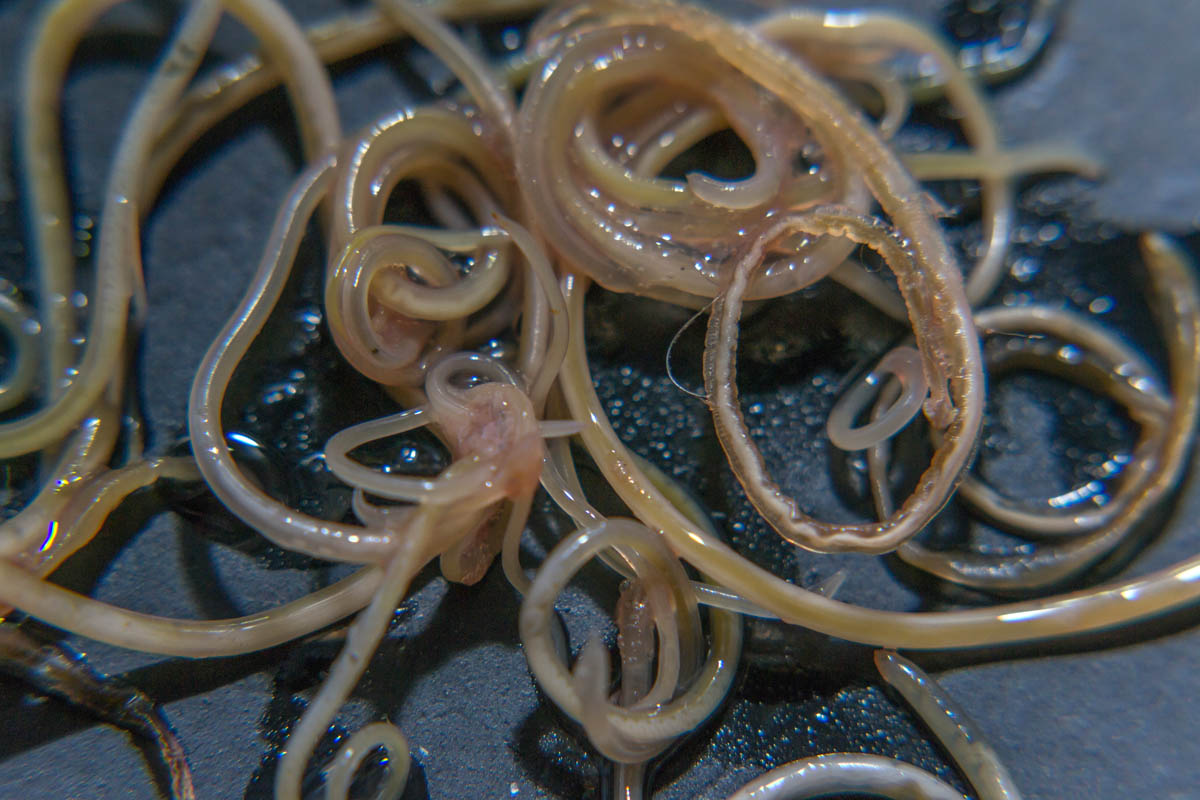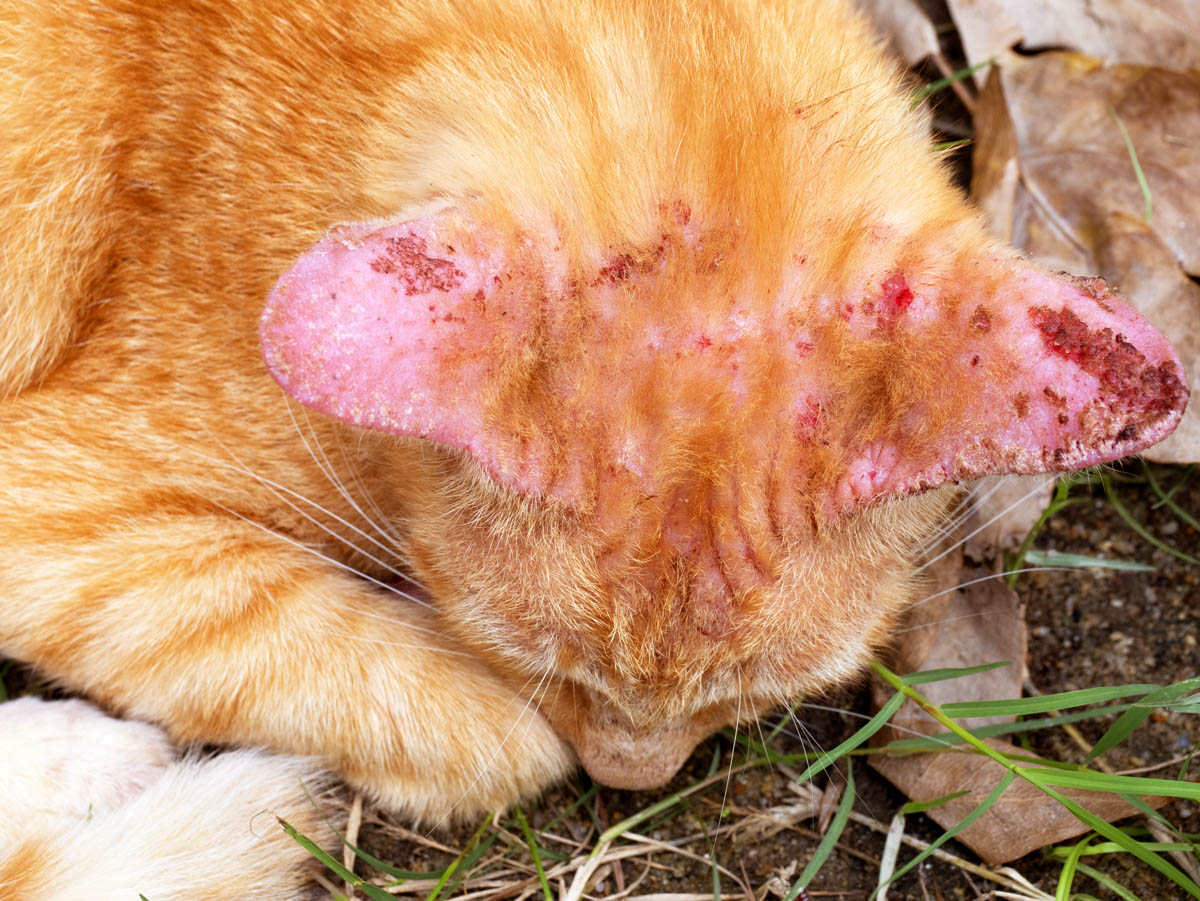Yes, you can although they don’t develop in the same way, they would in your cat. Infection is more common in children than in adults.
You will notice two phrases that are similar in this article: cutaneous larva migrans (CLM) and visceral larva migrans (VLM). CLM most commonly occurs with hookworms and VLM with roundworms. VLM is far more serious than CLM.
Hookworm

You can become infected with hookworms, but they don’t develop into adult worms as they do in the cat. Eggs are shed in the feces of the cat (or dog) and develop into larvae in around 2-3 weeks. Infection occurs when a human comes into direct contact with these infective larvae, which can penetrate intact skin. They attempt to migrate towards the blood vessels (as they would in the cat or dog) but lack the enzyme necessary to penetrate the deeper layers of the skin and eventually die.
This migration through the skin is known as cutaneous larva migrans (also called ‘creeping eruption’ or ‘ground itch’). Humans are dead-end hosts as larvae aren’t able to penetrate further than the outer layers of skin like they would do in the cat or dog and develop into adult worms.
The incubation period is generally between 1-2 weeks. Infection with hookworms presents as a red, extremely itchy, linear or snake-like eruption on the skin. Migration occurs at a rate of approximately 1cm a day. The most commonly affected areas are the feet, legs, buttocks, and hands but infection can occur on any part of the body which comes into contact with soil or sand. It is also possible to become infected after coming into contact with towels that have been sitting on the ground infected with hookworm larvae. It occurs mostly in tropical and sub-tropical areas.
This condition while somewhat creepy (pardon the pun) is relatively harmless and self-limiting. Anti-worming medication can treat an active infection. Secondary infection can develop in some people requiring antibiotics.
Roundworm

Humans become infected with roundworms by ingesting the eggs via contaminated soil (oral route) or larvae via raw/undercooked meat containing encysted larvae. Another route of infection is via fomites (contaminated objects such as towels). It takes several weeks before the eggs within the feces become infective in the soil.
Once ingested, eggs hatch into larvae and penetrate the walls of the digestive tract, migrating to various tissues in the body, which causes an inflammatory response. This migration is known as visceral larva migrans migrans or toxocariasis. Young children, especially those with pica are at the highest risk, although infection can occur in anybody.
As with hookworms, the roundworm larvae aren’t able to complete their life cycle within the human host, however, during migration the body mounts an immune response, leading to inflammation of the affected tissues, resulting in damage. If roundworms migrate to the eyes (ocular larva migrans), blindness can occur. Other organs affected include the liver, lungs, heart, and brain (rarely.
Unlike cutaneous larva migrans which predominantly occurs in tropical or sub-tropical areas, visceral larva migrans can occur in colder climates also.
Symptoms of infection may include coughing, itchy skin, wheezing, abdominal pain, loss of vision.
Diagnosis can be made via a blood test to detect antibodies.
Treatment may not be necessary where no symptoms are present when treatment is required, antiparasitic medication such as albendazole will be prescribed.
Tapeworm

Tapeworm infection via cats is rare in humans. For us to become infected, we have to swallow a flea infected with tapeworm.
Ringworm

I’m going to cover this because it has the name “worm”, but ringworm isn’t a worm at all, it is a fungal infection. People can and do catch ringworm from cats and cats can catch ringworm from humans.
Transmission occurs via contact with infective lesions or indirect contact with towels, bedding etc. Ringworm appears as raised, circular lesions on the skin which may itch.
Treatment of ringworm is the use of an anti-fungal cream or oral medication.
What can I do to prevent a worm infection?
- Wash hands thoroughly after handling a pet.
- Regularly de-worming your cat.
- Properly dispose of cat feces and discourage cats from going to the toilet in the garden. Scoop out litter trays at least once a day.
- Sandpits make an attractive toilet for cats when not in use, cover it up to prevent cats going to the toilet there — carefully checking for cat feces before allowing your child to use it.
- Wear shoes outside.

